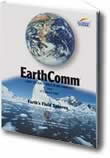This investigation will help you to:
- Seawater Temperature, Salinity, and Density
- Water Masses in the Ocean
- What Causes Deep Ocean Circulation?
- To complete the investigation, each student group will need:
- To learn more about how volcanic eruptions at divergent boundaries affect deep ocean currents, visit the following web sites:
- To learn more about how atmospheric circulation affects deep ocean circulation, visit the following web sites:
- To learn more about how the rotation of the Earth affects deep ocean circulation, visit the following web site:
- To learn more about how the biosphere is affected by deep ocean circulation, visit the following web sites:
- "General Characteristics of the World's Oceans" - NASA Institute on Climate and Planets
Site reviews the general characteristics of the oceans, including temperature and salinity. Click on link at bottom of page to advance. Site contains several full-color images.
- Using flotsam to study ocean currents - NASA
This article contains information regarding the spill of shoes and rubber duckies in the Pacific that students investigate in Activity 3, specifically how the spill led to a greater understanding of ocean circulation patterns.
- "Tracers, time scales, and the thermohaline circulation: The lower limb in the North Atlantic Ocean" - Fine, R.A., 1995, Rev. Geophys., Vol. 33 Suppl., AGU
This online papers introduces the concept of thermohaline circulation and how it relates to climate. The second and third sections of the paper are a bit more technical, reviewing research techniques for tracing water masses in the ocean.
- Water source
- Salt
- Balance scale (to weigh the salt)
- Transparent plastic shoebox
- 1 liter beaker (to measure water)
- Food coloring (red and blue)
- Thermometer
- Copies of the Atlantic and Pacific Ocean cross sections (one for each student)
- To generate additional maps of vector winds (as shown in the student text), visit the NOAA Climate Diagnostics Center web site. The maps in the student text were generated by selecting "Vector Wind" as the variable, Analysis level of 1000 mb, the same beginning and ending month (in this case, November), one year (1997 or 2000), in color and shaded, Plot type of "mean", no contour intervals, Custom map projection, latitudes from -50 to 50, longitudes from 90 to 300, and Cylindrical Equidistant projection. To generate additional maps, try varying the months and years, or the variables that you plot.
To learn more about how volcanic eruptions at divergent boundaries affect deep ocean currents, visit the following web sites:
- "Submarine Volcanoes" - Volcano World
Reviews the basics of plate tectonics and examines closely submarine volcanoes at divergent and convergent boundaries and hot spots. The site has good images of underwater lava flows as well as images of the organisms that live near these submarine volcanoes. - "Submarine Volcanoes, Ridges, and Vents" - NOAA Vents and Volcanoes
Site inlcludes content essays on hydrothermal vents, the Mariana back-arc, submarine volcanoes, submarine arc volcanism, and more.
To learn more about how atmospheric circulation affects deep ocean circulation, visit the following web sites:
- "Surface Wind Fields Over the Oceans" - NASA's Earth Observing System
This site includes a color image showing the wind patterns over the Pacific and explains how wind patterns form and are documented by scientists.
To learn more about how the rotation of the Earth affects deep ocean circulation, visit the following web site:
- "Tides and the Earth's Rotation" - NASA Global Geophysical Fluids Center
To learn more about how the biosphere is affected by deep ocean circulation, visit the following web sites:
- "Exploring the deep ocean floor: Hot springs and strange creatures" - USGS
Online article takes a look at some of the organisms which live on the ocean floor. Includes color photos. - Dive and Discover: Expeditions to the Seafloor
Expedition 2 in particular has some information about life at sea vents.

